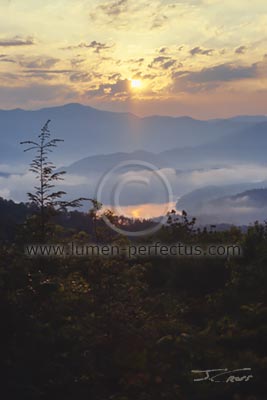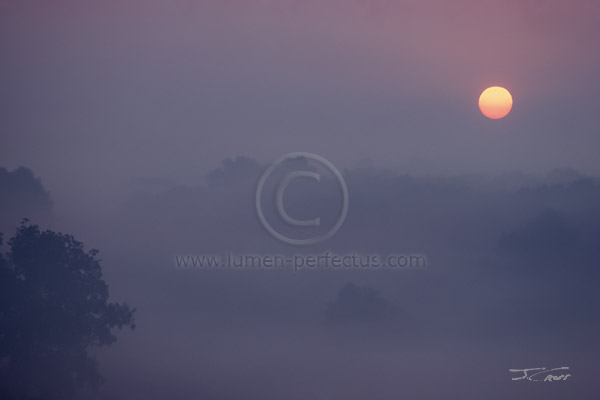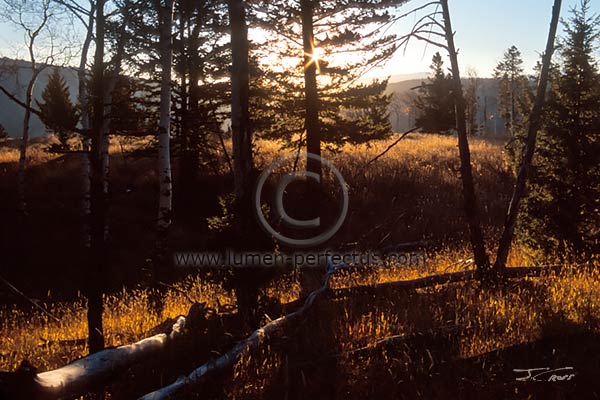www.lumen-perfectus.com
New Old Pictures, Redux
“Photographs open doors into the past, but they also allow a look into the future.”
Sally Mann

Sunrise, May, 1978, Great Smokey Mountains National Park, North Carolina.
Near the end of 2016 I bought some new scanning equipment, and then followed a somewhat convoluted path to get software that helped maximize the quality of scans made with both the new (Epson) and old (Nikon) scanners. I wrote about this in my December, 2016 article, “Everything Old Is New Again.” I won't repeat those details here.
Now, a little over a year later, we're in the middle of a difficult winter of snow, ice, wind, very cold temperatures, with the occasional moderate day of rain. The number of sunny days we've seen since early November is barely more than the number of teeth in the average chicken. And it's only February. Yesterday I plowed more than a foot of snow from the driveway. Drifts reached nearly to my waist thanks to high winds the previous night. It seems this winter isn't even thinking about being over. Cold, windy, snowy, gloomy; these are days tailor-made for working indoors, scanning and cataloging my old 35mm slides dating from 1973 to early 2007, when I shot my last roll of film.
As mentioned in the article linked above, I have thousands of slides. Most are junk, but ignoring my own advice I've kept far too many. To make up for that failing, most of these slides are poorly organized. Those worth a second look, however, have long ago been separated from the herd, and are loosely grouped by location. This means I can start a scanning “project” by choosing a subject, a location, a year, or some combination of those criteria, resulting in a manageable stack of slides on which to work. For reasons not interesting enough to relate here, I recently decided to make new scans of the film images in this site's Sunrise and Sunset gallery. With a couple of exceptions, the first three pages of that gallery are all scans of film images. Many had been scanned with older, lower-resolution equipment. Doing this would also give me the opportunity to watermark the jpegs for the site, something I have found necessary (alas) to do to frustrate image-stealing Web sites. I'm talking to you, Pinterest, although you're not alone.
Re-opening an Old Goldmine

Buried treasure, from 1973, in what would become Cuyahoga Valley National Park.
I easily found the slides that had been scanned years ago and posted to the site. Most of them, anyway. While hunting through slide boxes looking for the few stragglers I found several others I felt were good (some of which aren't part of the Sunrise/Sunset gallery), and added those to the project. It's exciting to find “new” images this way. It's a bit like finding buried treasure. I think this happens because over the years one develops a style, a recognizable type of image, be it preferred lighting conditions, composition patterns, or even subject selection. Whatever it might be, it's perhaps less present in thirty-year-old pictures, and finding something in that archive that appeals to my eye today is an unexpected pleasure.
Taking the project even farther from the original scope, I gathered six slides I made in Yellowstone in October, 2005. I made the images for assembling into a panorama. At that time I didn't have the panorama photo gear I use now, and had only a vague idea how to set up to make the individual pictures. I made the scans and assembled them using the PhotoMerge application in Photoshop CS. The result was awful, with edge banding that required hours of touch-up work, but I liked the final picture. To my sunrise/sunset project I added remaking this panorama.
Scan, Document, Process, Repeat
With the slides now at hand I began scanning and processing. Scanning slides is not an exciting task. Each scan requires cleaning the slide, inserting it into the Nikon V-ED scanner, making a preview scan, checking focus and possibly adjusting the scanner's focus point because often slides aren't very flat, making adjustments in the SilverFast Ai Studio scanning software, and finally making the scan. This creates a 4000ppi, 125 megabyte .tif file. The time needed varies depending on slide condition, flatness and image quality, and some of the settings made in SilverFast. It can range from three or four minutes per slide to nearly twenty. Once the .tif is saved, I add copyright information and other metadata to the file. I mark the slide mount with the file name and enter that into a database, and then file the slide in a binder sleeve. That bit of bookkeeping takes an additional few minutes.
Although I've now got significant experience with the SilverFast software, it's quirks and bugs still drive me crazy and cost some time and frustration. However, with careful adjustments SilverFast can sometimes pull detail from shadow areas while helping to minimize grain, which enables further processing with Photoshop. This is not always successful, but it is often worth taking a little additional time to try.
Worth the Effort?
It's a lot of work collecting the slides, scanning, processing, cataloging, and then updating the Web site. It takes hours, and because I'm fussy about image quality, it's taken multiple passes through the process to get the best from some of the slides. Backing up the resulting set of files from each completed scan consumes 300 megabytes to over a gigabyte of server space, depending on the image (panoramas can be huge). But I do think it's been worth the effort; the improvement in final image quality ranges from a lot to a little. That's impossible to quantify, but the results are often gratifying.
Remember the above-mentioned Yellowstone panorama from 2005? I made new scans, which assembled and blended almost perfectly with Photoshop CC 2018's version of PhotoMerge. The result, slightly cropped in length, is the picture at the top of the page. This is one of those greatly improved from the original effort.

A May, 2005, sunrise in Yellowstone National Park.
In the fall of 2017 I promised myself I'd take some of the coming winter's down-time and work on my older film images. I'd made that promise before, but this winter (2018) is the first time I've kept it. Most of the scans and final Photoshop files and Web site jpegs are improvements over the older work. An added bonus is the “new” slides I've found while working on this. I have many more slides now properly cataloged (physically, and in the files' metadata) and safely filed in archival binder sleeves. Chances are nobody cares about this but overly anal types like me. But it's like polishing the tarnished silver once a year; the job is a pain in the ass and takes a lot of time, but it's ultimately very satisfying. Of course, in this case my pile of flatware to be polished is endless, and the job will never be complete. I'll just keep chipping away at it.
February, 2018
All products and brand names mentioned are trademarks or registered trademarks of their respective owners.